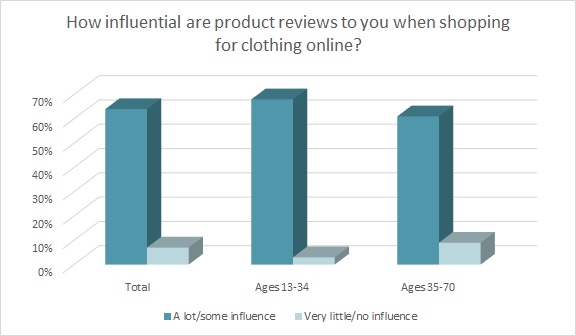It’s no secret that the COVID-19 pandemic has led to significant growth in ecommerce over the last two years. But stores and brands might not realize the importance online reviews play in increasing visibility, improving products, and boosting sales.
Essentially, review collection is not a ‘one and done’ activity; it’s something that needs to be an ongoing effort. And of course, if a brand or retailer is collecting a regular stream of review content, the overall volume continues to pay conversion dividends.”
Andrew Smith
Vice President of Marketing, PowerReviews
“It’s going to be really hard to rank higher than your competition if you don’t have reviews,” says Dhiraj Nallapaneni, product marketing writer at Birdeye, a review management software firm. “Just to emphasize this point, 92 percent of customers consult online reviews before making a purchase decision. It’s going to be tough — or it’s going to be tougher than it needs to be — to attract new customers to your business without reviews. So then the question becomes how do you get new reviews?”
Birdeye’s “2021 State of Online Reviews” report finds 67 percent of all reviews are written on Google, 45 percent of review requests were sent through text messaging and retail businesses sent more review requests than any other industry in 2020.
But just having reviews isn’t enough. PowerReviews, a software company that manages feedback and reviews, says 97 percent of consumers consider review recency to be at least somewhat important when considering a purchase. Nearly half (44 percent) want to see reviews that were written within the past month.
“Brands and retailers often make the mistake of thinking that review recency isn’t as important as review volumes,” says PowerReviews’ Andrew Smith, vice president of marketing. “Based on our survey results, this is clearly not the case. The recency factor is of equal importance to consumers. Essentially, review collection is not a ‘one and done’ activity; it’s something that needs to be an ongoing effort. And of course, if a brand or retailer is collecting a regular stream of review content, the overall volume continues to pay conversion dividends.”
Nearly two-thirds of consumers (64 percent) say product reviews are influential when they’re shopping for clothes online, according to the 2020 Cotton Incorporated Lifestyle Monitor™ Survey. Among consumers who use reviews, nearly 9 of 10 (87 percent) say they read customer reviews when they’re thinking of purchasing a particular product, and 74 percent read them when they’ve decided what to purchase but want to make sure it is the right choice, according to the Cotton Incorporated 2020 Customer Comments Survey (February 5, 2020).

Apparel shoppers, 71 percent of whom read customer reviews when looking to buy clothes online, are looking for specific information when they check out reviews, according to the Monitor™ research. More than 2 in 5 (42 percent) look to customer reviews to gauge a garment’s size and fit.
Among consumers who write reviews, 21 percent wrote their most recent evaluation because they value reviews and want to help others when buying, according to the 2020 Customer Comments Survey. Another 21 percent wanted to share a positive experience with others, 14 percent wanted to share specific information about the product such as sizing and care, and 13 percent wanted to warn others about a negative experience.
Trustpilot, an online reviews platform, gave a webinar titled Bad Reviews Happen, and says the way they’re handled makes all the difference.
“Over a third of consumers expect a response to their bad reviews,” says Trustpilot’s Theo Robson, business development manager. “When people leave feedback, they’re not just having a rant online about their bad experience. They’re leaving that door open, and want you to respond, engage and start a dialogue with them. They’re hoping you’ll listen, help and learn from it.”
Customers notice when brands aren’t responding to consumer concerns. In fact, the majority of apparel consumers (84 percent) say if they read multiple negative reviews citing the same issue, they wouldn’t buy the product, even if they had really wanted to buy it, according to the 2020 Customer Comments survey. They would also be deterred from buying if they read multiple negative reviews, each citing a separate issue (50 percent).
But there’s hope for businesses that are hit with negative reviews. Trustpilot says 64 percent of consumers would prefer to buy from a business that’s responsive to negative feedback over one that seems perfect.
“Consumers are actually three times more likely to buy from a company that has made a mistake — if they respond to their review quickly and try to rectify the mistake,” Robson says, adding that customers don’t want a robotic response, either. “Using their names and signing with yours is important. And if you can personalize the message further, that’s great.”
Consumers also say it would be a turnoff to see multiple reviews that appear to have been computer generated or written by bots (28 percent), according to the 2020 Customer Comments survey.
Birdeye’s Nallapaneni says under no circumstances should retailers or brands buy reviews.
“Some people might be tempted to do this after hearing about benefits like higher search rankings,” he says. “But this is a big risk and it will backfire. You’re risking fines by the FTC. You’re risking penalization in your search ranking by Google, and probably most importantly, you’re risking customer opinion of your business. Nobody can sell your business like your customer and nobody can really fake that customer voice either. It’s not hard to tell when a review is fake, so do not do this.”
Instead, Nallapaneni suggests brands email and text all of their customers asking them to review a product, preferably the same day of the sale, when the product is fresh on their minds. The reviews can then be linked to sites that matter like Google and Facebook. Review software can automate this process, and Nallapaneni says businesses that do automate average an 8 percent increase in revenue after 6 months.
Birdeye says managing online reviews presents an opportunity for stores and brands to attract more customers, improve local search rankings and “tell your side of the story. Every business should be closely watching their online reviews and responding quickly to feedback — good and bad.”
